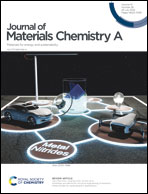Nitrogen reduction reaction energy and pathways in metal-zeolites: deep learning and explainable machine learning with local acidity and hydrogen bonding features†
Abstract
Conversion from very inert nitrogen to ammonia is crucial to the industrial production of fertilizers and other fundamental chemicals. To predict the possible reaction pathways and barriers of the nitrogen reduction reaction (NRR) in metal-zeolites, we set up a dataset consisting of electronic structures and reaction energies for 492 metal-zeolite structures with 27 metal elements (including 3d, 4d, and 5d transition metal and main group Pb and Bi metal atoms). The important role of hydrogen bonding (HB) interaction in facilitating the hydrogenation step (N2* → NNH*) but disfavoring the dehydrogenation step (NNH3* → N*) of the NRR is revealed by using a graph convolutional neural network (GCNN) model with the multilevel attention mechanism. A local acidity (LA) descriptor is defined by the combination of the electronegativity, first ionization energy, and atom radius of the embedded metal in various substrates (including zeolites, 2D materials, etc.), from which good predictivity of reaction energies was gained by using explainable machine learning (ML) models (e.g., XGBoost: R2 = 0.84) with an addition of geometry distortion and charge transfer descriptors along reaction pathways. The pathway probability of distal, alternating, and enzymatic processes is also predicted from the geometry and charge features with satisfactory performance. The promising zeolites with embedded Ti, Co and Nb atoms were recommended to favor the NRR with lower energy inputs of 0.13, 0.04, and 0.54 eV. For experimentally synthesized photocatalytic Ti-exchanged zeolites, the ML predicted maximum energy inputs are decreased with decreasing LA values, in line with the increased ammonia yield from 4A, 3A, to 5A of pore sizes. The predictive model for energy and pathway prediction and the LA descriptor could also be transferred to metal decorated 2D materials and non-metal B-containing systems.



 Please wait while we load your content...
Please wait while we load your content...